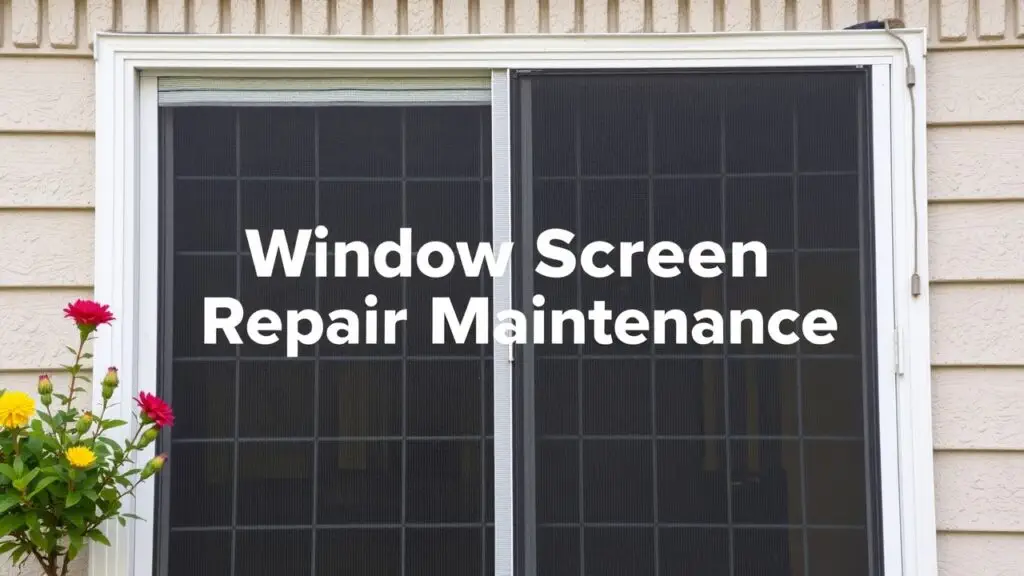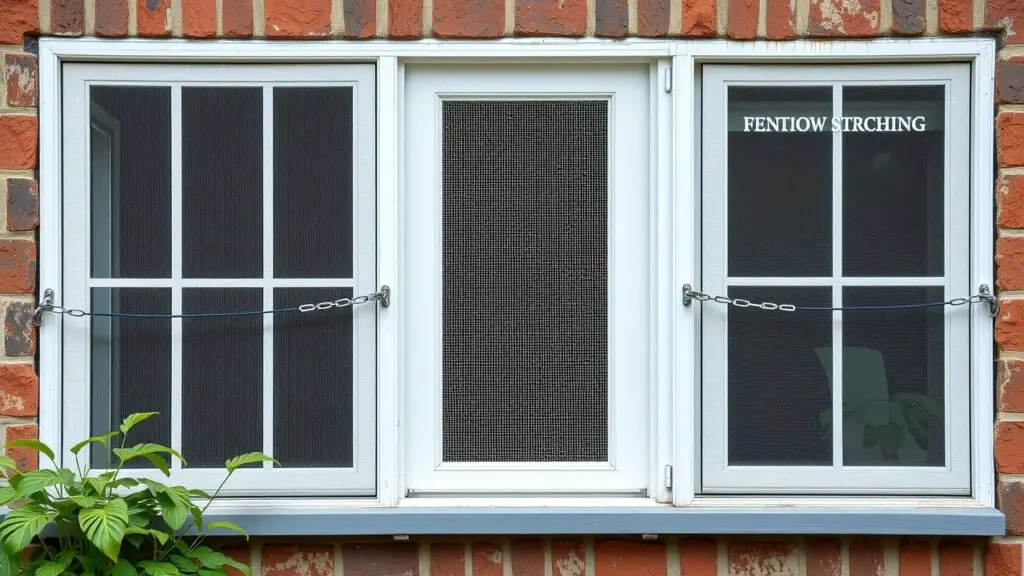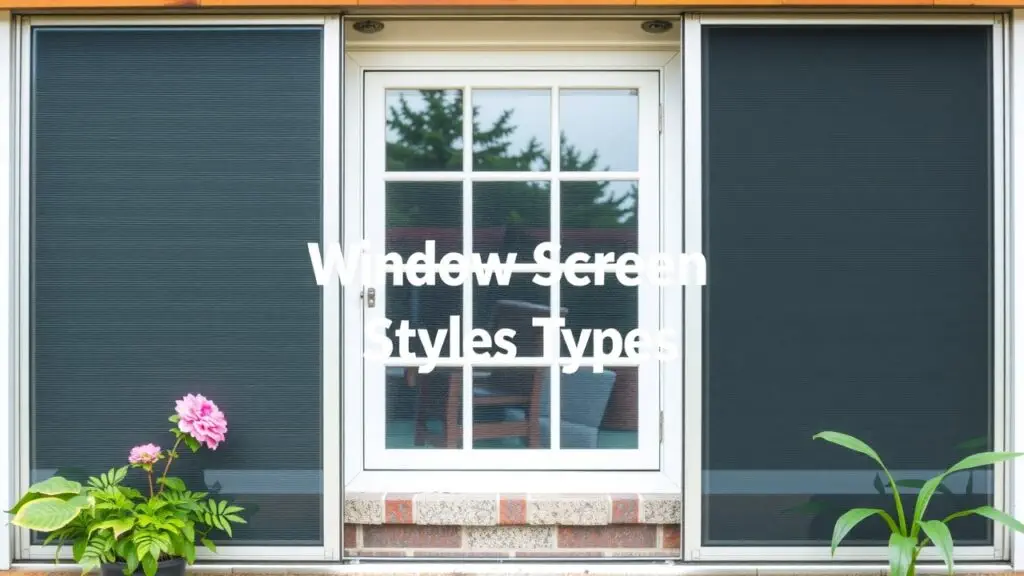Types of window screens vary widely; this guide covers materials like fiberglass and aluminum, frame styles, and how to choose the best screen for your needs, including mesh options and installation tips.
What Are Window Screens and Why Do You Need Them?

Window screens are barriers made from different materials that fit into window frames. They serve many important purposes, making them a must-have for any home.
Key Functions of Window Screens
- Insect Protection: A main job of window screens is to keep bugs out while letting fresh air in. This is super useful during warm weather when insects are active.
- Airflow Regulation: Screens let homeowners enjoy fresh air without worrying about bugs. You can keep windows open and enjoy ventilation, all while keeping pests outside.
- Sun Control: Some types of window screens reduce glare and block harmful UV rays. This helps protect your indoor furniture from fading over time.
- Security Enhancement: Security screens add an extra layer of protection against break-ins but still let you see outside and allow airflow.
Picking the right type of window screen is key since it affects how your space looks and works.
Benefits of Installing Window Screens in Your Home
Putting in window screens can bring a bunch of benefits that improve comfort and efficiency in your home:
- Energy Efficiency Improvements: Energy-efficient window screens can cut down cooling costs by lowering heat inside during hot days. This means you won’t have to use your air conditioning as much.
- Enhanced Indoor Air Quality: Good ventilation helps keep the air fresh inside your home while keeping pests away, which is great for your health.
- Protection Against UV Rays: Special screens, like solar screens, not only filter sunlight but also protect your furniture from fading due to too much sun exposure.
Knowing these benefits can help homeowners choose the best types of window screens for safety, comfort, and saving energy.
Types of Window Screen Materials Explained
Fiberglass Window Screens – Affordable & Versatile Option
Fiberglass window screens are a go-to choice for many homeowners and DIYers. They are lightweight and flexible, which makes them easy to handle during installation. These screens are made from woven fiberglass strands. The common mesh size is 18×16, which works great for most homes. There are tighter weaves available that keep out bugs better.
Pros and Cons
Here’s what you should know about fiberglass screens:
Pros:
- Cost-effective
- Simple to install, making them great for DIY projects
Cons:
- Not as durable as metal options
- Can wear down over time from weather exposure
Aluminum Window Screens – Durable & Long-lasting Choice
Aluminum window screens are known for their strength. They resist corrosion, so they hold up well in different climates. These screens are perfect for busy areas or homes with pets due to their sturdiness.
Best Use Cases
Aluminum screens work best in places where you need durability. Think of patios or main entrances that see a lot of traffic.
Pros and Cons
Here’s a quick look at the good and bad:
Pros:
- Long-lasting
- Great resistance to rust
Cons:
- Can get dents if hit hard
- Some people find them harder to install than fiberglass
Stainless Steel Window Screens – Superior Strength and Durability
Stainless steel window screens stand out because of their strength. They resist corrosion too, making them ideal for tough weather conditions.
Mesh Sizes and Applications
These screens come in various mesh sizes, just like other types. You can use stainless steel in residential windows for pest control or in commercial buildings where you need something long-lasting.
Pros and Cons
Let’s break it down:
Pros:
- Very long lifespan
- Highly durable under stress
Cons:
- More expensive than fiberglass or aluminum
Other Metal Options Beyond Aluminum Include Copper Meshes & Stainless Steel Models
Besides aluminum and stainless steel, copper meshes have unique benefits too. They look nice and have natural properties that fight germs.
Unique Properties
Copper’s color adds charm while also keeping insects away without chemicals. Bronze meshes offer a rustic look but can be heavier compared to other metal options.
Pros/Cons Overview
Both copper and bronze have their perks but can cost more than standard materials. Think about what you really need before choosing these options!
Window Screen Styles and Types
Retractable Screens: Convenience and Flexibility
Retractable window screens are a great choice for many homes. They mix convenience with flexibility. You can find different types, like vertical, horizontal, and motorized screens. Vertical screens go up and down to cover windows or doors. Horizontal ones slide open sideways. Motorized options let you control them with a remote. These screens are easy to use and very versatile. You can pull them back when not in use, so you have clear views. However, they often cost more than fixed screens. They work best for large openings like sliding glass doors or patios where you want fresh air without losing style.
Magnetic Screens: Easy Installation and Removal
Magnetic window screens are super easy to install and take down. They’re perfect for DIY lovers! These screens have mesh panels that stick using magnets. You just walk through them, and they part easily, snapping back when you’re done. One big plus is their simple setup—you don’t need any tools! They work well as temporary solutions for seasonal use but may not last as long as other types due to weather exposure over time.
Pleated Screens: Space-Saving Design
Pleated window screens are neat because they fold up when not in use. This space-saving design helps you enjoy the breeze without making your room feel cramped. While they look stylish, pleated screens can be pricier than fixed or magnetic options due to how they’re made.
Fixed Screens: Traditional and Reliable
Fixed window screens are one of the oldest styles around. Installing them usually means securing frames onto windows with screws or adhesive strips. They’re easy to install and maintain, which is why many homeowners like them. But keep in mind that they aren’t very versatile; once they’re up, you can’t move them aside easily like retractable options.
Sliding Screens: Smooth Operation
Sliding window screens work like sliding patio doors—they glide along tracks smoothly! This makes it easy to get in and out while keeping airflow in your home. When picking a sliding screen style, think about how often you’ll need access through that area so you can choose wisely based on your needs!
Choosing the Right Mesh Size
Understanding Mesh Count and its Impact
When you pick window screens, knowing about mesh size is key. The mesh count tells you how many openings fit in a square inch of the screen material. If the mesh count is high, it means smaller holes. This is great for keeping out insects while still allowing airflow and visibility. But with a low mesh count, the holes are bigger, which means more light and air can come through, but pests can get in too.
For insect screens, a common choice is 20×20 mesh. It has 20 holes both up and down. This size does a good job of blocking most bugs while letting air flow through nicely. If you care more about seeing out than keeping bugs out, you could go for a 16×16 or even an open weave like 14×14.
Here’s a quick recap:
- Higher Mesh Count: Great for pest control; less airflow.
- Lower Mesh Count: Better visibility; more chance of bugs getting in.
Mesh Size Recommendations for Different Needs
Picking the right window screen size really depends on what you need it for. Check out this comparison for some helpful recommendations:
| Application | Recommended Mesh Size | Benefits |
|---|---|---|
| General Insect Protection | 20×20 | Blocks small insects well |
| High Visibility Areas | 16×16 | Good mix of airflow & view |
| Pet-Friendly Screens | 18×14 | Strong against scratching |
| UV Protection | Fiberglass with UV coating (varies) | Cuts glare & protects from fading |
Every application needs something different when it comes to mesh size. For example, if you have pets, you might want stronger materials like fiberglass or aluminum. These can handle some wear and tear without losing too much protection from pests.
How Mesh Size Impacts Other Factors?
The mesh size not only keeps pests away but also affects how long your screens last and how much maintenance they need. Larger meshes are often less durable because they have fewer threads holding them together. They might tear easily or get damaged by pets or weather.
Smaller meshes tend to collect dirt and debris more quickly due to their tight weave. But if you buy good quality materials, they can last longer even if they’re finer woven.
Energy efficiency also plays a part when choosing window screens based on their mesh sizes. Smaller meshes help block drafts while still letting some natural light in. This can keep your indoor temperature steady throughout the year.
To wrap it up:
- Larger Meshed Screens: Easier to maintain but may not last as long.
- Smaller Meshed Screens: Better for energy efficiency but could need more frequent cleaning due to dust build-up.
Frame Materials: Durability and Aesthetics

Choosing the right window screens means picking the best frame material for durability and looks. The most common options for window screen frames are aluminum, vinyl, and wood.
Aluminum Window Screens
Aluminum is a strong choice. It does not rust, and it’s lightweight but sturdy. This makes it great for different weather. Plus, you can paint aluminum frames in various colors to match your home’s style.
Vinyl Window Screens
Vinyl frames are good for insulation. They resist fading from sunlight, which is a plus. While they are often cheaper than aluminum, they might not last as long. Vinyl comes in some colors but has fewer options compared to aluminum.
Wood Window Screens
Wooden frames give a classic look that many love. But they need care, like painting or staining, to stop them from rotting. While wood looks beautiful, it might not hold up as well against harsh weather compared to metal.
Your choice of frame material should meet your needs for both durability and style.
Frame Styles: Functionality and Installation
Window screens come in different styles that affect how they work and how easy they are to put in. Knowing these styles helps you pick the best one for your windows.
- Outswing Window Screens: These screens open outward from a hinge at the top or bottom. They fit well with casement windows where outside space is tight.
- Inswing Window Screens: Made for double-hung windows, these screens open inwardly. This makes cleaning simple since you don’t need to reach outside.
- Fixed Window Screens: Fixed screens stay in place all the time. They let in lots of light while keeping bugs out.
- Sliding Windows Screen Types: These screens slide alongside sliding doors or windows, making access easy without needing to remove the whole screen.
Installing window screens varies by type but usually starts with measuring your window accurately. Then you can cut the frame material as needed. For detailed steps on how to install each type effectively, check instructions from manufacturers or DIY guides.
Choosing the Right Frame: Factors to Consider
Picking the right window screen frame involves thinking about several things:
- Budget for Window Screens: Figure out how much you want to spend now and later on maintenance costs.
- Aesthetics of Frames for Windowscreens: Think about how each frame matches your home’s design—be it modern or traditional—and choose colors that fit.
- Window Type Considerations: Look at what kind of windows you have (like casement vs double-hung) because this affects which styles fit best.
- Screen Frame Styles Available: Learn about all the styles so you can decide based on what works best functionally and visually.
By considering these points carefully, you can find a window screen that meets your needs!
DIY Installation Guides: Step-by-Step Instructions
Installing window screens is easy! Follow these steps to do it yourself:
- Measure Your Windows: Measure the width and height of your window frame carefully. This helps you choose or cut the right size screen.
- Choose Your Screen Type: Pick the window screen that fits your needs—fiberglass, aluminum, retractable, or magnetic screens. Each has its own perks.
- Gather Materials: You’ll need a screen frame kit (if not using pre-made screens), screening material, spline (to hold the screen), scissors, and a flathead screwdriver.
- Cutting the Frame: If you’re making your frames, cut them according to your measurements with a miter saw or hacksaw.
- Assemble the Frame: Use corner connectors from your kit to join the pieces into a rectangle that matches your window size.
- Attach Screening Material: Lay out the screen over one side of the frame. Press it down firmly before placing the spline on top to keep it secure. Use a flathead screwdriver to push it into place.
- Trim Excess Material: After securing with spline, trim any extra screening around the edges for a neat look.
- Install Screens into Window Frames: Fit your new or purchased screens into their windows by pressing them gently against any clips or tracks designed for this purpose.
This guide ensures a successful installation of easy-to-install window screens tailored for all types of windows.
Window Screen Repair: Common Problems and Solutions
Window screens can have some common issues over time due to wear and tear or weather:
- Tears and Holes: Small tears can be fixed with patch kits from stores. Bigger holes might need replacing parts of the mesh.
- Loose Screens: If screens get loose in their frames because splines wear out, replace those parts as needed.
- Bent Frames: If aluminum frames bend from hits or bad weather, straighten them carefully without breaking them.
Deciding whether to fix things yourself or call someone? Here’s how to choose: - Try DIY methods for small issues like tiny rips or loose fittings.
- Call a pro if you have major damage needing special tools beyond regular home repair skills.
Cleaning and Maintenance: Extending the Lifespan of Your Screens
Cleaning regularly keeps screens looking good and working well:
- Remove Screens Periodically: Take off removable screens every few months depending on how dusty it is where you live.
- Use Mild Detergent Solution: Mix warm water with some mild soap then scrub gently with soft brushes. Avoid rough materials that can scratch surfaces, especially fiberglass types which can break easily.
- Rinse Thoroughly: After cleaning, rinse well under running water until all soap is gone so they’re nice and clean again!
- Inspect Regularly: While cleaning, check for signs needing attention like rust or cracks. Fixing these early prevents bigger problems later!
By sticking to these tips for cleaning and maintenance, homeowners can help their window screens last longer!
Best Window Screens for Pets
When you have pets, picking the right window screens is super important. You want durable ones that can handle scratching and clawing. Pet-resistant window screens are made tough so pets can’t easily damage them. These screens often use strong materials and tighter mesh sizes, which help keep your furry friends safe.
Materials and Mesh Sizes That Resist Pet Damage
The most common materials for pet-resistant window screens are fiberglass, aluminum, and polyester. Fiberglass is light but might not last as long as aluminum. Aluminum is stronger but can block some visibility. Polyester mesh is great too because it doesn’t tear easily while still letting air flow through.
Choosing the right mesh size matters a lot! A smaller mesh size like 18×14 works better for bigger pets. It keeps them safe while allowing good airflow and visibility.
Durable Window Screens
Look for window screens that have been tested for strength and long-lasting use. Many companies back their pet-resistant models with warranties, which makes it easier for pet owners to feel good about their choice.
Best Window Screens for Insect Protection
Insect protection is a big deal when picking out window screens. Good insect screens stop bugs from getting in without cutting down on fresh air or sunlight.
Types of Window Screen Mesh
There are different types of mesh you can choose from:
- Standard Fiberglass Mesh: This allows decent airflow while keeping insects out.
- Tight-Mesh Options: If you live where tiny bugs like no-see-ums are common, tight-mesh options (like 20×20) are a smart choice.
- Pet-Proof Mesh: Some special meshes combine both pest control features and durability that’s great for homes with pets.
Picking the right mesh size based on local insects can really boost your home’s pest control game.
Energy-Efficient Screens

Energy-efficient window screens help save money by providing solar shading and UV protection without blocking all the natural light.
Benefits of Energy-Efficient Window Screens
These screens can help keep your home cooler during hot days by bouncing sunlight away while still letting in fresh air. They also protect your furniture from fading due to UV rays, which helps keep your décor looking nice longer.
Buying energy-efficient options not only cuts down utility costs but also helps the environment by using less energy at home.
Screens for Security and Safety
Keeping your home secure should be a top concern when you choose window screens. Security screens do multiple jobs like helping keep kids safe and deterring burglars.
Material Strength and Resistance
Good security screens usually use stainless steel or strong aluminum frames along with reinforced mesh that resists cutting or tampering.
If you have kids or pets, security designs make sure windows stay locked tight yet easy to access when needed—giving parents peace of mind while keeping daily life simple.
FAQs About Window Screens
What are the different types of window screen materials?
Window screens are made from various materials. Common choices include fiberglass, aluminum, stainless steel, copper, and bronze. Each has its own benefits.
How do I choose the right window screen for my needs?
Consider your priorities. If you want durability, choose aluminum or stainless steel. For budget options, fiberglass works well. Think about whether you need pet-resistant or insect-protecting screens.
What mesh size is best for insect protection?
For effective insect control, use a tighter mesh size like 20×20. This keeps out smaller bugs while allowing airflow.
Can I install window screens myself?
Yes! Many screens come with DIY installation kits. Follow instructions carefully for a successful setup.
How do I maintain my window screens?
Regular cleaning helps extend their lifespan. Remove dust and debris with mild soap and water to keep them functional and looking good.
Additional Topics on Window Screens
Window Screen Materials Overview
- Fiberglass: Affordable and versatile.
- Aluminum: Durable and rust-resistant.
- Stainless Steel: Highly durable but more expensive.
- Copper: Offers natural germ resistance.
- Bronze: Rustic appearance but heavier than others.
Window Screen Styles and Their Uses
- Fixed Screens: Simple and reliable.
- Sliding Screens: Easy access for sliding windows or doors.
- Retractable Screens: Convenient for large openings.
- Magnetic Screens: Quick installation without tools.
- Pleated Screens: Space-saving and stylish options.
Choosing the Right Frame Material
- Aluminum Frames: Lightweight yet sturdy.
- Vinyl Frames: Good insulation but limited durability.
- Wooden Frames: Classic look that needs maintenance.
Pet-Resistant Window Screen Options
- Look for durable materials that withstand scratching.
- Consider using polyester mesh for extra strength against pets.
Insect Screen Types for Home Protection
- Standard fiberglass screens provide good visibility while keeping bugs out.
- Tight-mesh options are ideal for areas with small insects like no-see-ums.
These points will help guide your choices when considering window screens for your home improvement projects.
Related Topics
- types of window screen materials
- types of window screen frames
- types of window screen styles
- types of window screen mesh
- types of window screen installation
- types of window screen repair
- types of window screen frame materials
- types of window screen frame styles



Types of Window Screens: A Complete Guide to Materials, Frames, & Styles